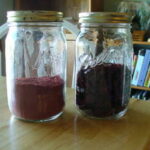A survivalist garden isn’t that much different than a regular vegetable garden, there is just more of the day-to-day basics in it. A regular vegetable garden might have a little of everything, but the survivalist garden has a lot of the staples.
The advent of the freezer changed the survivalist garden immensely. A survivalist garden used to be composed of root crops and canning crop, but has now turned to almost all types of garden fruit and vegetables. A survivalist garden will have nut trees, fruit trees and berries and most types of vegetables. The vegetables in the survivalist garden will contain several that have a high protein count such as chickpeas, sunflowers for their seeds, and pumpkin. Pumpkin gives you a “twofer”. You can use the shell for pumpkin pie puree, the filling for pumpkin pies, and also for their seeds. Here are two articles that contain the recipes.
http://www.associatedcontent.com/article/420612/save_halloween_pumpkins_for_this_christmaspie.html
http://www.associatedcontent.com/article/420693/pumpkin_puree_ideas_pie_bread_and_more.html
You don’t need a lot of land to create one that will feed a family of four for the winter. You simply need good planning. If you are limited in space you want the vegetables and fruit to give you the most bang for your buck. If you are just starting as a survivalist gardener you will want to add one fruit tree or bush each year and focus on fruits that are more immediate.
A vegetable garden is usually a casual growth that is meant for summer food and perhaps a little to put up for the winter. The vegetable gardener will have a lot more lettuce and day-to-day types of foods like radishes in the garden. The planning is not as necessary since the garden is not meant to feed the family for the winter.
Must haves in a survivalist garden. PUMPKINS and SUNFLOWERS! The sunflowers are the easiest since you can line your property borders with giant sunflower. They are beautiful but beware. We had squirrels, birds, and other animals after our seeds also. When the heads are ripe and turn brown, cut them down and hang them upside down inside to dry. Be certain to wrap the heads in a bag or cheesecloth to prevent the dry seeds from scattering to the floor.
Pumpkins can be grown in a cage to save space. You will have to train the vine, but the effort is worth it. I have also grown pumpkins mixed around other vegetables and allowed the vine to wander. Both seeds are high in protein and have a multitude of uses. I usually plant about six pumpkin plants in cages or as wanderers.
I will be writing an article on uses for the sunflower seeds in plenty of time before you harvest them. Adding the seeds to your families diet can reduce the amount of animal protein necessary and give you more independence from the grocery store. (I have never been able to even consider raising an animal to slaughter, so I won’t put it in the article. There is nothing wrong with it, but I get attached to plants and have a difficult time using some of them, so an animal is out of the question for me.) You can’t have too many sunflowers. What you don’t use can be shared with the birds.
Even though I don’t usually grow my own peas, the effort isn’t worth the bounty; I have planted enough for a few meals and put crops that produce later spaced between the plants. You can maximize your garden by watching for the harvest time of each plant.
When you are growing carrots you also can do a continuous planting. As some of the carrots are maturing, plant the new ones close by. Make certain that you don’t put them too close that they will be disturbed when you are pulling the mature carrots. Plant them in a row slightly back and alternating the more mature ones, and you will have a consistent flow of fresh vegetables and a manageable flow of ones to freeze for the winter.




